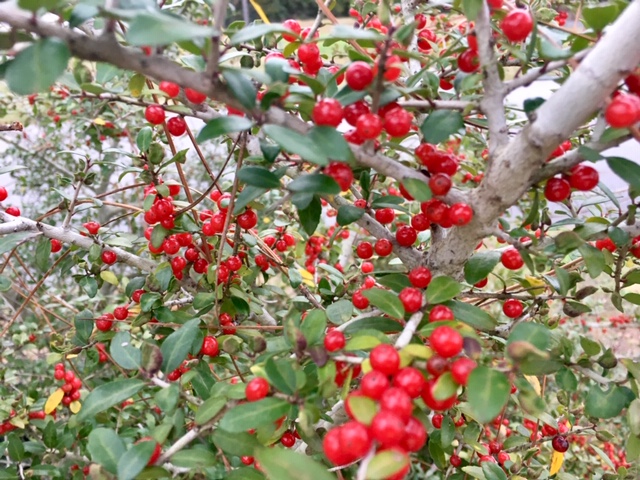
by Larry Williams | Dec 4, 2020
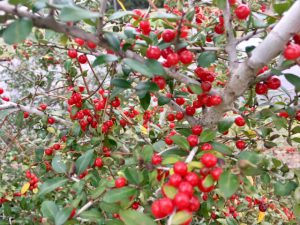
Native yaupon holly with bright red winter berries. Photo credit: Larry Williams
Holly plants are sometimes associated with Christmas. Their dark evergreen leaves and bright red berries fit right in with the Christmas Season. Some people intentionally plant hollies for the purpose of eventually using this desirable combination of green and red to create a more festive Holiday Season. But what if your hollies never produce berries?
The reason may be because you have a male plant. Male holly plants never produce berries. Holly plants are either male or female. The botanical term for this is dioecious. If a male plant is selected, it will produce male flowers and pollen but never set fruit.
One way to know that you’ve selected a female holly is by purchasing a plant with berries. However, you still will need a male plant nearby or no berries will be produced. Generally one male plant is adequate to insure pollination and good fruit set of berries on all female plants in a landscape. Your next-door neighbor may have a male holly plant that would serve as a pollinator for your hollies. Pollen produced by male flowers is transported by bees from distances up 2 miles. And because we are blessed with a number of native hollies in North Florida, chances are good that there will be a male holly within the appropriate distance in the wild to take care of the pollination.
The holly genus (Ilex) offers a terrific variety of plants from which to choose. Some horticulturists estimate that there are about 700 species worldwide. And there are a great number of cultivated varieties! When selecting a holly for your landscape, it is important to know that most dwarf holly cultivars don’t produce fruit as they are propagated by cuttings from male plants. Not all hollies have spiny leaves. For example, many of the Japanese hollies (Ilex crenata) have spineless leaves. There are hollies that grow tall, eventually making a tree. There are dwarf hollies that grow to only three to five feet in height. There are hollies with variegated leaves. And even though most hollies are evergreen, there are a few deciduous hollies that make nice additions to North Florida landscapes such as Ilex ambigua (Ambiguous Winterberry) and Ilex decidua (Possumhaw holly). Some hollies produce bright red berries but berry color varies from red, orange, yellow and even black or white, depending on variety. There are weeping forms available such as the weeping yaupon holly. There are those that have a very narrow, upright growth habit.
For more info on this diverse and interesting group of plants, visit the below UF/IFAS Extension webpage.
http://gardeningsolutions.ifas.ufl.edu/plants/trees-and-shrubs/shrubs/holly.html

by Larry Williams | Dec 4, 2020
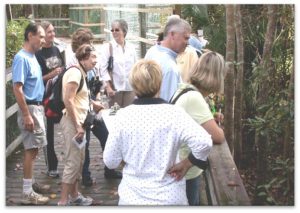
Larry teaching Master Gardener Volunteers about the connection of their landscapes to the watershed
Larry is the Residential Horticulture Agent and Master Gardener Volunteer Coordinator with UF/IFAS Extension in Okaloosa County. He has served in this position for 26 years assisting County residents in developing and maintaining Florida-Friendly lawns, landscapes and gardens.
Larry says that Extension has been impactful in his life since he was a youth. He remembers a “County Agent” bringing tomato plants to his elementary school class, providing instructions on how to grow them and providing each student with their own tomato plant to take home for a tomato growing competition though the local Extension 4-H youth program. Being familiar with land-grant universities and their research and Extension publications, he frequently used this resource in completing course work at both Abraham Baldwin Agricultural College (ABAC) and at the University of Georgia, earning degrees in agriculture and agriculture education. He later earned a Master of Education degree from the University of West Florida.
It was a high school agriculture teacher and FFA Advisor who was the main influence for Larry pursuing a degree as an Agriculture Teacher himself. While teaching high school as an agriculture/horticulture teacher and an FFA Advisor, Larry introduced his students to Extension by having the County Extension Director as a guest speaker in the classroom and working with the Extension office with agriculture events, including youth livestock shows as well as other FFA and 4-H youth events. When deciding to leave teaching high school, it was

Larry teaching youth about gardening
the local County Extension Director who asked Larry if he had ever considered a career with Extension. That planted a “seed” that Larry pursued, serving as an Extension Agent in two unban Counties and one rural County in Georgia and currently serving as an Extension Agent in Okaloosa County, FL. Larry was the first Horticulture Agent and established the Master Gardener Volunteer program in Okaloosa County.
Larry has worked in the areas of agriculture, forestry and horticulture, but horticulture is his passion. He has been employed with a large commercial greenhouse operation, a retail garden center, a landscape company, operated a city greenhouse and nursery, worked as a city arborist and owned and operated his own landscape business.
Larry writes a weekly garden column for the Northwest Florida Daily News and has a weekly garden radio program for WAAZ 104.7 in Crestview.
He enjoys spending time with his two children, providing learning experiences for youth and adults through Extension Education and doing some gardening himself. He says, “Never underestimate the impact you’ll have on youth when teaching them about gardening.”

by Larry Williams | Oct 28, 2020
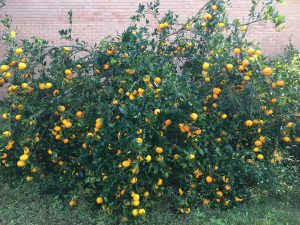
Nice fall crop of satsuma fruit. Photo credit: Larry Williams
When asked what kind of citrus to grow here in North Florida, my default response is satsuma. I usually get a funny look, followed by an attempt by the person who’s asking to repeat the name satsuma. The individual may ask, “What is satsuma… is that a citrus?” I guess the person expected to hear orange, grapefruit, lemon or maybe tangerine.
Satsuma is a type of citrus, technically classified as a mandarin and is sometimes referred to as satsuma mandarin. The satsuma mandarin is a good candidate for the North Florida citrus enthusiast for a number of reasons.
- Historically, mature dormant trees have survived minimum temperatures of 14°F to 18°F when budded/grafted to a cold-hardy rootstock such as trifoliate orange or swingle, a trifoliate orange cross. Young trees are not as cold-hardy but, due to their smaller size, are more easily covered with a cloth such as a sheet or lightweight blanket for protection during freezes.
- Satsuma fruit are ready to harvest October through December, ripening before the coldest winter temperatures. This is not true with most sweet citrus types such as oranges, which are harvested during winter months. Harvesting during winter works well in Central and South Florida where winters are mild but does not work well here in extreme North Florida. The potentially colder winter temperatures of North Florida are likely to result in the fruit on sweet oranges freezing on the tree before they are ripe, potentially ruining the fruit.
- Our cooler fall temperatures result in higher sugar content and sweeter fruit.
- Fruit are easily peeled by hand, have few to no seed and are sweet and juicy.
- Trees are self-fruitful, which means that only one tree is needed for fruit production. This is important where space is limited in a home landscape.
- Trees are relatively small at maturity, reaching a mature height of 15 to 20 feet with an equal spread.
- Branches are nearly thornless. This may not be true with shoots originating at or below the graft union. Shoots coming from the rootstock may have long stiff thorns. These shoots should be removed (pruned out) as they originate.
Satsuma fruit are harvested in fall but trees are best planted during springtime when temperatures are mild and as soil is warming. Availability of trees is normally better in spring, as well. For additional cold protection, purchase a satsuma grafted on trifoliate orange rootstock and plant the tree on the south or west side of a building. There are a number of cultivars from which to choose.
For more info on selecting and growing satsuma mandarin, contact the UF/IFAS Extension Office in your County or visit the following website.
https://edis.ifas.ufl.edu/ch116

by Larry Williams | Oct 1, 2020
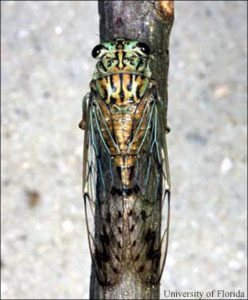
Adult cicada on tree branch, Photo credit: Lyle Buss, UF Entomologist
“What is that noise,” asked the visitors to Middle Georgia when I was a teenager. They were visiting during the summer from El Paso, Texas. I asked, “What noise?” The reply, “That loud noise in the trees.” I responded, “Oh, those are cicadas.’ There are sounds that are so common that sometimes you quit hearing them.
Before the visitors left for El Paso, I made sure to show them the brown, dry shells (exoskeletons) of cicadas that are not difficult to find attached to the trunk of a Georgia pine tree during summer. Cicadas leave their nymph exoskeletons on the trunks of trees and sometimes shrubs when they shed them to become mature flying adults.
You may not have ever seen a cicada but you’ve undoubtedly heard one if you live in Florida. These insects make a loud buzzing noise during the day in the spring and summer. Male cicadas produce their distinctive calls with drum-like structures called timbals, located on the sides of their abdomens. The sound is mainly a calling song to attract females for mating.
Cicadas spend most of their life underground as nymphs (immature insects) feeding on the sap of roots, including trees, grasses as well as other woody plants. They can live 10 or more years underground as nymphs. In some parts of the United States, there will be news reports of when periodical cicadas are expected to emerge from the ground. Periodical cicada species mature into adults in the same year, usually on 13- or 17-year life cycles. Their numbers can be enormous as they emerge, gaining much local attention. However, cicada species in Florida emerge every year from late spring through fall and in much smaller numbers as compared to the periodical cicadas.

Cicada emerging from exoskeleton, Photo credit: Lyle Buss, UF Entomologist
There are at least nineteen species of cicadas in Florida, ranging from less than a ¼ inch to over 2 inches in length. Some people might be frightened by their size and sounds but thankfully cicadas don’t sting or bite. They are a food source for wildlife, including some bird species and mammals.
Very rarely, I’ll have someone ask about small twigs from trees found on the ground as a result of the female cicada’s egg-laying process. But because this is usually such a minor issue with practically no permanent damage to any tree, cicadas really aren’t considered to be a pest of any significance in Florida.
For more information on cicadas, contact the University of Florida Extension Office in your County. Or visit the following UF/IFAS web page. https://edis.ifas.ufl.edu/in602

by Larry Williams | Aug 14, 2020
Oleander caterpillars, which are active on some oleanders during summer, can provide a number of gardening lessons.
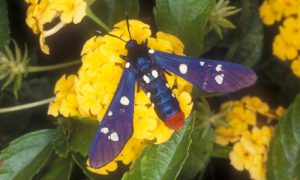
Oleander caterpillar moth on lantana flower. Photo credit: James Castner, UF
The adult moth is striking in appearance. The bluish to purplish moth has white dots on its black wings. The moths resemble wasps as they fly in and around oleander shrubs.
It’s the orange caterpillars with black spots and black hairs that cause problems for some gardeners.
Caterpillars are the larval stage of butterflies and moths. In order to enjoy watching butterflies and moths feeding on the nectar of flowers, some of the caterpillars must survive to become adult butterflies and moths. This is lesson number one.
Oleander caterpillars usually only feed on oleander plants. Oleanders are native to areas of Europe and Asia. This is lesson number two.
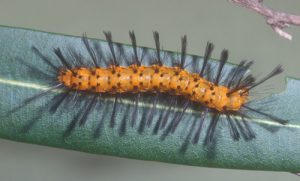
Oleander caterpillar, Photo credit: Paul Choate, UF
Oleander caterpillars benefit by us planting their food source in Florida.
This relationship between pest and plant is referred to as the key plant, key pest concept. Some other examples include St. Augustinegrass and chinch bugs, gardenias and whiteflies, crape myrtles and crape myrtle aphids, azaleas and azalea caterpillars, camellias and tea scale, roses and black spot, pecans and pecan scab, squash and squash vine borers.
Understanding this concept can be helpful in designing a “low maintenance” landscape.
When you plant roses, you plant everything that goes with roses, including the time and money required to maintain them. This applies to St. Augustinegrass, pecan trees, squash and oleanders. This is lesson number three.
Oleander caterpillars can temporarily damage the appearance of oleanders. But they cause no long-term damage for the plant. This is lesson number four. The damage is aesthetic. Oleander caterpillars can consume great numbers of leaves. However, if the plant is otherwise healthy, new leaves will be produced and the plant will continue to grow. The damage is temporary; there will be no evidence the plant ever had a problem.
To spray or not to spray for oleander caterpillars has to do with a person’s tolerance level.
If you can’t tolerate having oleander caterpillars around and the temporary aesthetic damage they cause, consider the use of Bacillus thuringiensis. It is sold under a number of brand names and many times is referred to as Bt. This bacterium only controls caterpillars so it is friendlier for the beneficial insects. When using any pesticide, always follow the label directions and precautions.
Here are links to UF/IFAS Extension publications with more info.













